Exploring the Allure of Large Round Engagement Rings
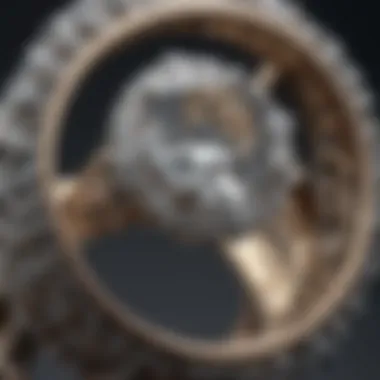
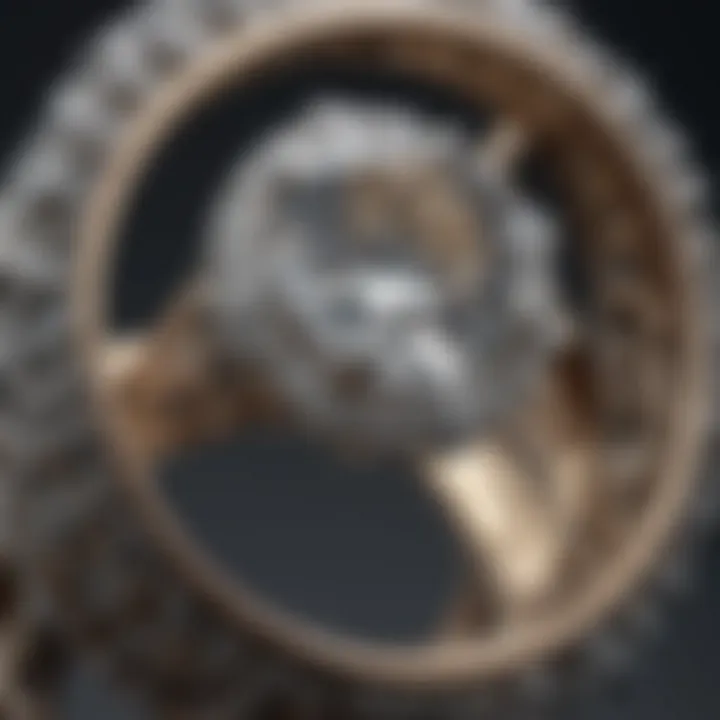
Intro
Large round engagement rings evoke a sense of luxury and romance, making them a popular choice for couples embarking on a lifelong journey together. These rings are not just accessories; they are symbols of commitment and love. Understanding their various facets—from the type of gemstone to their historical significance—can greatly enhance one’s appreciation and decision-making process for such important pieces of jewelry.
The allure of these prominent gemstones extends beyond their physical beauty; it taps into cultural narratives and personal stories that resonate with individuals on many levels. In this comprehensive guide, we will delve into the captivating world of large round engagement rings, covering everything from style variations to the jewels themselves and why they hold special significance.
Gemstone Overview
Large round gems frequently take center stage in engagement rings, and for good reason. Their brilliance captivates the eye and their size often signifies a commitment of epic proportions.
Definition and Characteristics
At its core, a gemstone is defined by its crystalline structure and its beauty. Crucial characteristics include:
- Hardness: Measured on the Mohs scale, this indicates how resistant a stone is to scratching. Diamonds, for instance, score a perfect 10, making them the hardest of all gems.
- Clarity: This refers to the presence of internal or external flaws, known as inclusions. The clearer the stone, the more valuable it tends to be.
- Color: Color can range wildly, affecting both aesthetic appeal and price. While diamonds are often associated with being colorless, they come in shades ranging from yellow to blue.
- Cut: The way the stone is cut and shaped can dramatically influence its sparkle and overall beauty. A well-cut diamond, for example, will showcase its brilliance more effectively than a poorly cut one.
The round cut remains the most popular due to its symmetrical shape, which maximizes light reflection, creating a stunning sparkle.
Classification of Gemstones
Gemstones can generally be divided into two categories: precious and semi-precious. However, this classification can often be debated based on factors like tradition and availability.
- Precious gemstones typically include diamonds, rubies, sapphires, and emeralds. These are highly sought after and come with a significant price tag due to their rarity and beauty.
- Semi-precious stones, on the other hand, include varieties like amethyst, garnet, and aquamarine. They may be more abundant, but they can still offer unique charm and captivating colors.
Furthermore, considerations such as cut, color, clarity, and carat weight can steer buyers toward specific types of large round gemstones to fulfill their personal narratives; hence, understanding these categories is crucial.
Historical Significance
The value of large round engagement rings extends beyond their material worth. Their history is steeped in cultural significance that adds layers to their meaning.
Ancient Uses and Cultural Importance
Historically, gemstones have captivated humans since prehistoric times. Ancient civilizations believed gemstones held power, serving various purposes, from amulets for protection to symbols of wealth and status. For instance, in ancient Egypt, lapis lazuli was revered and often used in burial artifacts as a means of connecting with the divine.
Cultural practices also evolved. In medieval Europe, gemstones became included in betrothal rings, marking the beginning of their association with engagement and love. The round cut, in particular, is said to symbolize eternity, a fitting representation of the commitment involved in marriage.
Myths and Legends Surrounding Gemstones
Every gemstone carries its own lore. Diamonds were thought to bestow invincibility and strength; rubies symbolize passion and courage. The legends surrounding these stones can inform modern buyers, adding weight to the choice of a gemstone.
"The charm of gemstones lies not just in their design but in the stories they carry through time, connecting the past to the present."
Thus, grasping both their historical significance and enchanting narratives can greatly influence the appreciation of large round engagement rings.
Prelude to Large Round Engagement Rings
Large round engagement rings have long held a special place in the hearts of many, symbolizing commitment and love in a distinctive way. Their unique blend of elegance and brilliance has made them a popular choice for couples seeking to express their feelings through something truly remarkable.
The significance of this topic lies not just in the aesthetic appeal of the rings themselves, but in the layers of meaning and cultural relevance they bring. Round stones, often associated with eternity due to their continuous form, tap into historical nuances and modern interpretations that define contemporary love.
When considering a large round engagement ring, one must also weigh various factors. From the stone's size and cut to the chosen metal and setting, each element contributes to the overall beauty and symbolic weight of the ring.
In this comprehensive guide, we will delve into the defining characteristics of large round stones, their historical context, and various facets that buyers should consider. This exploration offers essential insights not only for those in the market for an engagement ring, but also for enthusiasts who appreciate the artistry behind these stunning pieces.
Defining the Large Round Stone
Defining large round stones goes beyond just dimensions or shape; it's about understanding their allure and what they represent. A round stone, particularly in the context of an engagement ring, is recognized for its ability to capture and reflect light spectacularly. The most sought-after cut, the round brilliant cut, features 58 facets which maximize brilliance and sparkle, giving it an almost magical quality.
But a large round stone is also about giving a statement. These rings often evoke a sense of grandiosity and significance. When sized adequately, a round stone can serve as both the focal point of the ring and a canvas for intricate designs around it. Buyers should consider not only the size of the stone but the quality of the cut and clarity too, as these factors heavily influence the ring’s overall appearance.
Historical Context of Round Engagement Rings
The history of round engagement rings traces back to ancient civilizations. The tradition of using rings to symbolize unions can be found as far back as Egyptian times, where linked designs represented eternity. The round shape inherently aligns with this notion—no beginning and no end.
In more modern times, the round engagement ring became iconic around the 20th century, notably popularized by Charles Lewis Tiffany who transformed the landscape with the introduction of the modern diamond engagement ring. Through the decades, round stones have been at the forefront, due in part to their unique ability to pair well with a variety of cuts and designs.
The duality of the round shape—both classic and contemporary—has allowed it to stand the test of time, making it a go-to choice for many couples today. This rich history adds depth to the emotional resonance of round engagement rings, portraying how something as simple as a circle can capture profound meanings throughout the ages.
The Significance of Stone Size in Engagement Rings
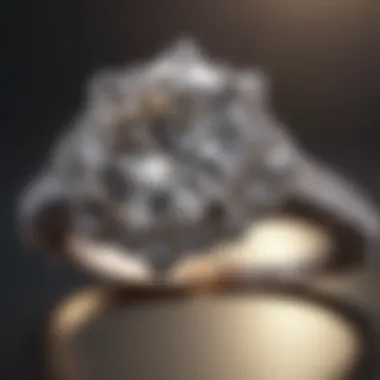
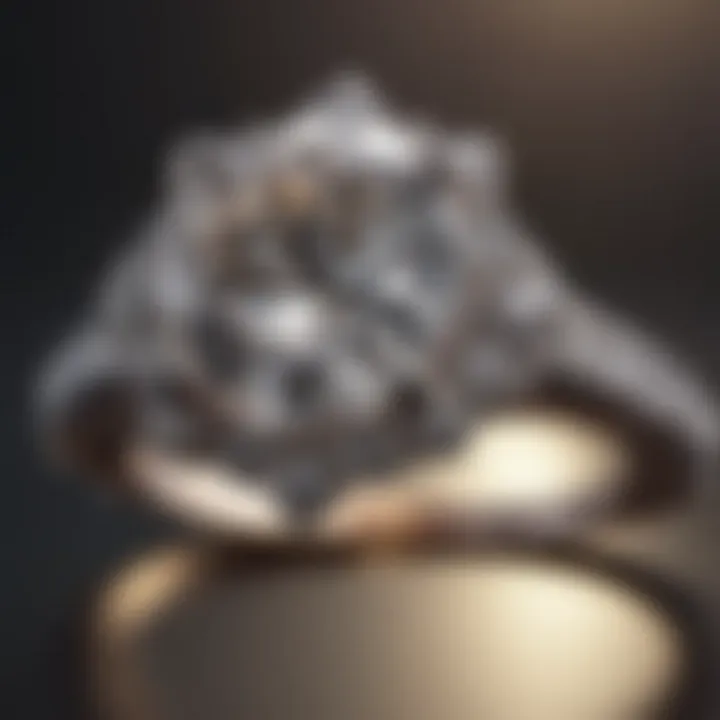
When it comes to engagement rings, the size of the stone holds considerable weight in both aesthetic appeal and cultural contexts. Opting for a larger stone often signifies a commitment that extends beyond mere romantic gestures; it embodies status, wealth, and, importantly, personal taste. Many people tend to associate the size of an engagement ring with the level of love or commitment, making stone size a significant factor in both purchase decisions and discussions surrounding engagement.
The number of facets, the stone’s clarity, and its overall brilliance can all be linked to its size. A larger round engagement ring can create a stunning visual impact that’s hard to ignore. This section delves into the nuances related to stone size, unraveling cultural perceptions and the psychological implications that accompany choosing larger stones.
Cultural Perceptions Related to Size
Cultural perspectives on engagement rings often draw a direct correlation between a stone's size and its perceived value. In many societies, larger diamonds are seen as symbols of status and success. The age-old adage, "bigger is better," rings especially true in certain contexts. People might think that a substantial stone reflects not only the commitment of the giver but also their financial stability.
In cultures where wealth and social hierarchy are vital, a larger stone can be interpreted as a direct representation of the giver's ability to provide. For example, in some Western cultures, it has become common for friends and family to compare engagement rings, and a larger size often garners admiration. This perception can lead to societal pressure not just for the person proposing, but also for the individual receiving the ring. It forms a kind of unspoken competition among peers, leading many to critique or uphold standards based on the size alone.
However, societal norms can vary significantly. In certain communities, a simpler, smaller stone may highlight a more profound sentiment associated with love rather than extravagance. In these cases, an oversized ring can seem out of touch or even undesirable.
Psychological Impact of a Larger Stone
The choice of a larger engagement ring stone isn't just influenced by aesthetics or culture; there's a psychological dimension as well. Studies have shown that jewelry, particularly engagement rings, can shape a person’s emotions, self-esteem, and even social identity. A larger stone can amplify feelings of pride and excitement for the wearer, often interpreted as a declaration of their worth in a romantic context.
The psychological validation that comes with owning a larger stone can be compelling. Many people feel a considerable boost in confidence when wearing a noticeable piece of jewelry. This elevation isn't just about vanity; it provides a sense of belonging and acceptance within chosen social circles. A larger diamond can symbolize emotional milestones, and wearing it is akin to carrying a badge of honor.
Ultimately, larger stones can serve as conversation starters, sparking discussions that connect individuals through shared values or perceptions of commitment.
"The size of an engagement ring isn't just about the diamond. It's a collective narrative that winds through society, perception, and personal value."
In essence, the significance of stone size in engagement rings transcends mere appearance. It reaches into the realms of culture, psychology, and social dynamics, thereby making it an essential consideration in the journey of selecting a memorable and meaningful piece of jewelry.
Popular Cuts for Large Round Stones
When it comes to large round engagement rings, the cut of the stone significantly influences both its beauty and its overall appeal. Cuts not only dictate how light interacts with the gem, but they also can reflect personal style and taste. The right cut can amplify the brilliance of a diamond or any gemstone and enhance its size, creating an eye-catching centerpiece for the ring.
Choosing the right cut matters immensely for a few reasons. First, a well-cut stone maximizes light performance. Second, it provides a certain character to the ring, making it more than just a piece of jewelry; it becomes a part of a love story. Thus, knowing the different cuts at one's disposal can help make an informed choice when selecting a large round gemstone.
The Classic Round Brilliant Cut
The classic round brilliant cut is perhaps the most recognized shape in the gem world. With its 58 facets, this cut is designed to maximize sparkle. The round brilliant cut is notorious for creating a captivating dance of lights, often referred to as "fire." As a natural diamond goes through the cutting process, maintaining a balance between depth and diameter is paramount. If done correctly, the result is a stunning visual that can dazzle at any angle.
One key advantage of this cut is its versatility. It pairs beautifully with a variety of settings, from solitaires to vintage-inspired styles. Furthermore, its universal appeal makes it a popular choice for those searching for a classic yet impactful ring.
"The round brilliant cut is the gold standard in diamonds—its brilliance is simply unmatched."
Other Notable Cuts: Variations and Styles
Beyond the classic round brilliant, there are other notable cuts that can add an individual flair to large round engagement rings. These alternative cuts, while not as ubiquitous, can tell unique stories and highlight the individuality of the wearer. Some of these variations include:
- Cushion Cut: This cut features soft, rounded corners and large facets, creating a vintage feel while offering a softer sparkle. Its shape can resemble that of a pillow, inviting a cozy aesthetic.
- Oval Cut: Although technically not a traditional round, the oval cut retains a similar brilliance while appearing larger than its weight would suggest. An oval cut can lend a more elongated look to the finger, which some find appealing.
- Modified Round: This approach tweaks the classic round design for additional uniqueness. With variations like the brilliant cut or hearts and arrows precision cuts, these styles often cater to the whims of those looking for something just a bit special.
- Pear Cut: Shaped like a teardrop, this cut is striking and carries a sense of romance. It has the ability to emphasize both elegance and personality, with a silhouette that draws the eye.
Choosing a cut ultimately boils down to personal preference and the effect one wishes to achieve. By exploring different styles, there's potential to find a setting that wonderfully complements the character of the large round engagement ring.
Design Considerations for Large Round Rings
When it comes to large round engagement rings, making design choices is crucial. The design of the ring doesn't just impact its aesthetic appeal; it also affects durability, comfort, and how well the stone sparkles. A well-thought-out design enhances the beauty of the stone and reflects the personality of the wearer. Understanding the elements of design is an important step in the journey of selecting the perfect ring.
Choosing a Setting: Pros and Cons of Various Styles
The setting of an engagement ring is a significant factor that plays a role in showcasing the round stone. When selecting a setting, one must carefully consider the pros and cons of various styles:
- Prong Setting
Pros: - Bezel Setting
Pros: - Halo Setting
Pros: - Cluster Setting
Pros:
- Maximizes visibility and light exposure to the stone
- Allows for intricate designs, making the ring more personalized
- It's often more affordable compared to other settings
Cons: - Less secure compared to settings like bezel
- Prongs can catch on clothing, leading to potential snagging
- Provides superior protection for the stone
- A modern look that suits many styles
Cons: - Can limit the amount of light that hits the stone, potentially affecting its sparkle
- Tends to be heavier, sometimes uncomfortable for everyday wear
- Surrounds the center stone with smaller diamonds, enhancing its size and brilliance
- Adds an extra layer of glam and can boost overall appearance
Cons: - Can be overwhelming if the stone is already large
- Requires more maintenance as smaller stones can become loose over time
- Creates a unique and bold look
- Can combine various gemstones for a personalized touch
Cons: - Can be less classic than other settings, which might not appeal to everyone
- Maintenance can be more challenging due to the multiple stones involved
Each of these settings can drastically change how a large round engagement ring looks and feels. One must weigh personal style against practical considerations.
Custom vs. Ready-Made Designs
Choosing between custom and ready-made designs presents another layer of decision-making when it comes to large round engagement rings. Both options come with their own sets of advantages and challenges.
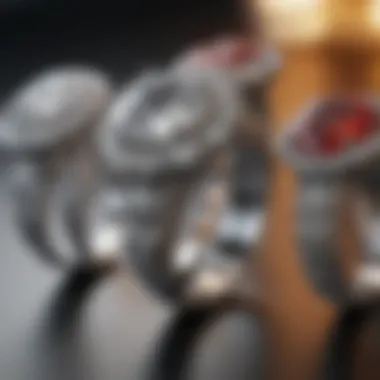
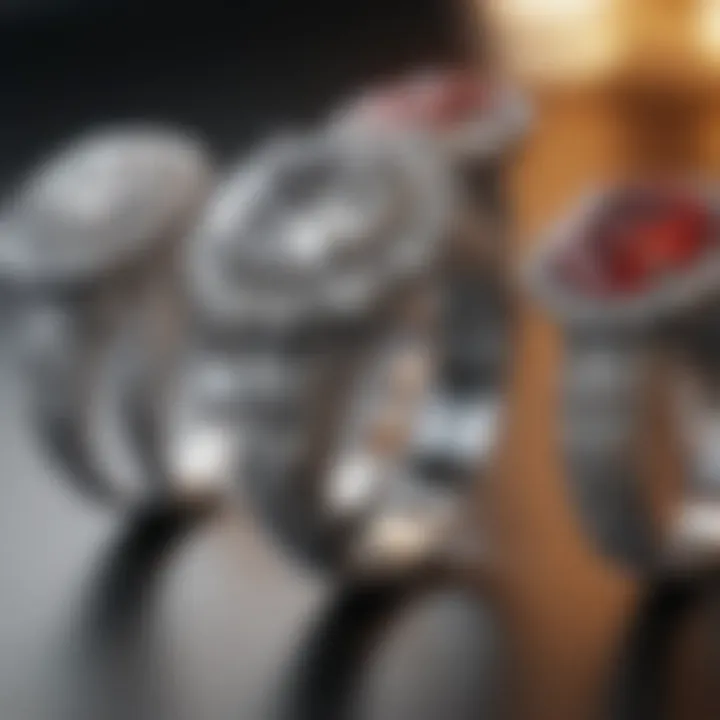
- Custom Designs
- Ready-Made Designs
- Benefits:
- Drawbacks:
- Tailor your ring to fit individual taste, ensuring it is one-of-a-kind
- The ability to select the exact features, such as metal type and stone quality
- Usually more expensive and may take longer to create
- Requires collaboration with a jeweler, which can be daunting for some
- Benefits:
- Drawbacks:
- Often more affordable and available immediately
- Can be viewed in person before buying, which helps gauge quality
- Limited in custom choices, adjustments may not be possible
- It’s possible to encounter a ring that someone else has
Material Choices for Bands and Settings
When it comes to large round engagement rings, the material choices for bands and settings play a crucial role—not just aesthetically, but also functionally. A well-chosen metal can elevate the entire look of the ring while also providing the necessary durability to withstand everyday wear. This section dives deep into the various metal options available, examining their unique characteristics and benefits.
Popular Metal Options: Gold, Platinum, and Beyond
Among the various materials, gold and platinum reign supreme due to their allure and strength. However, there are other contenders worth considering.
Gold comes in a variety of colors. The most common are:
- Yellow Gold: Classic and timeless.
- White Gold: Offers a more modern twist and pairs well with diamonds.
- Rose Gold: Gaining popularity for its romantic hue.
Each type has its own charm; yellow gold brings warmth, white gold provides a sleek finish, and rose gold adds a hint of vintage flair. However, gold isn't as hard as some other metals, which raises considerations for potential scratches and wear over time.
Platinum, on the other hand, is often regarded as the ultimate choice for those seeking luxury and permanence. It's denser and more scratch-resistant than gold, making it ideal for large stones that require a secure setting. The natural white sheen of platinum complements diamonds beautifully, enhancing their brilliance without overshadowing them. Though platinum is more costly, its durability makes it a worthwhile investment.
Apart from gold and platinum, other materials like palladium and tungsten are becoming more popular. Palladium shares many properties with platinum but usually comes at a lower price point, while tungsten is among the hardest metals available, suited for those who lead active lifestyles.
Comparing Durability and Aesthetic Appeal
The choice of metal significantly impacts the resilience and appearance of the engagement ring. Here are some key points to ponder:
- Durability: Platinum and tungsten are often noted for their hardness, making them less prone to scratches. Gold can be prone to dents due to its softer nature, especially in its 14k variation. Suggestions here would be to consider personal lifestyle before making a decision.
- Aesthetic Appeal: While some prefer the warm glow of gold, others might lean towards the cool elegance of platinum or the unique charm of mixed metals. The choice can reflect personal style, so think carefully about what resonates with you.
- Maintenance: Platinum requires some upkeep of its luster, as it can develop a patina over time; however, many people find this adds to its character. Gold settings may need more frequent polishing, especially when featuring intricate designs.
"The ring should not just be a piece of jewelry; it should resonate with the wearer's essence, matched with the right material to sustain its beauty and integrity over time."
Ultimately, the choice of band material is not merely about what looks good but also about practical considerations for everyday wear. Each material offers distinct advantages and challenges that should be carefully weighed, aligning with the buyer's lifestyle and preferences. This thoughtful consideration helps ensure the engagement ring remains a cherished symbol of love for years to come.
Complementary Gemstones: Enhancing the Center Stone
Large round engagement rings can certainly stand on their own, boasting magnificence and elegance. Yet, when paired with complementary gemstones, their appeal can soar to even greater heights. These additional stones are not merely decorative; they serve functions that enhance the overall beauty and significance of the ring. The thoughtful selection of accent stones enriches the aesthetic appeal while also allowing for personal expression.
Accents and Side Stones: Aesthetic Considerations
When integrating accents or side stones with a large round center stone, a few factors come into play. The choice of additional gemstones can either amplify or overwhelm the main stone. For instance, smaller diamonds, particularly in a pave setting, can add a breathtaking sparkle without detracting from the brilliance of the large round stone. In contrast, choosing bolder stones like sapphires or emeralds alongside a diamond can create a striking juxtaposition.
Typically, accents function not only to embellish but also to add layers of meaning. For example, one might choose side stones based on birthstones or stones of personal significance, which can create a deeper narrative for the ring. Among consumers, there's a growing trend in opting for unusual accents that speak to individuality, adding a delightful twist to traditional engagement rings.
"Accents can be seen as the exclamation point to the statement made by the center stone; they highlight its brilliance and personality, making the entire piece unique."
Choosing Gemstones with Meaning
Opting for gemstones that encapsulate specific values or memories can hold great significance in engagement rings. For example, many couples now express their individuality and shared dreams through the selection of gemstones that represent their love story.
- A blue topaz might be chosen for its calming properties, symbolizing serenity in the relationship.
- A garnet, embodying the essence of commitment and passion, could be a heartfelt tribute to a steadfast bond.
- Rose quartz, often associated with unconditional love, is gaining traction among couples who want to emphasize intimacy and connection.
When choosing these stones, it’s important to consider not only their aesthetic contribution but also their symbolism. Understanding the folklore or historical significance behind a gemstone can add depth to its presence in an engagement ring. Couples are encouraged to discuss family traditions or preferences they might have, allowing for a personalized touch in their selection process.
Ultimately, the choice of accent gemstones is a powerful way to express identity and sentimentality, enriching the overall experience and meaning attached to the engagement ring.
Consumer Trends and Market Analysis
Understanding consumer trends not only illuminates the current landscape of large round engagement rings but also provides insights into what buyers genuinely value. Knowing these patterns can be a game changer for those in the jewelry industry, potential buyers, and even historians looking into cultural significance. It’s like holding a mirror to society’s values, aspirations, and preferences, especially in a world where individual taste often collides with traditional norms.
Current Popularity of Large Round Engagement Rings
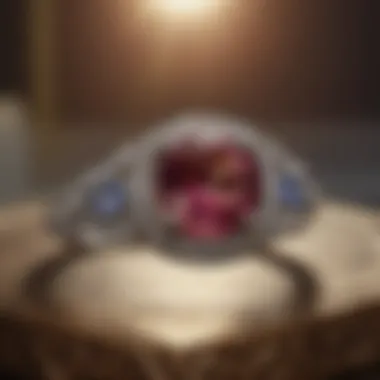
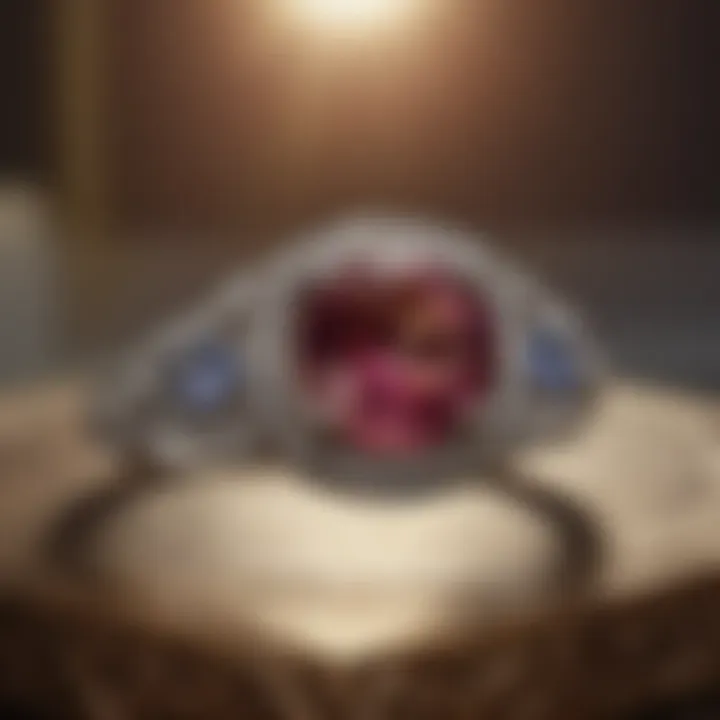
In the realm of engagement rings, large round stones hold a favorite position. The allure of a big round stone encapsulates timelessness while echoing modern chicness. In fact, surveys indicate that about 65% of engaged couples favor round cuts due to their brilliant sparkle and versatility with various settings.
- The aesthetic appeal is undeniably bewitching. A large round diamond can serve as a centerpiece, making even the simplest of bands sing with elegance.
- Social influences have also played a notable role. Celebrities flaunting their sizeable rocks often set trends, leading others to aspire for similar styles.
Moreover, there’s a growing appreciation for unique variations in styles—a modern bride may seek a stunning halo setting or unexpected accents that distinguish her ring from others.
Price Trends: Factors Affecting Large Stones
When it comes to pricing, the cost of large round engagement rings is influenced by several factors that prospective buyers must consider carefully.
- Carat Weight: Naturally, as the carat weight increases, so does the price. However, not all buyers realize the nuances involved; for example, a ring that’s 1.5 carats might cost significantly more than two stones that are each 0.75 carats, thanks to the rarity of larger gems.
- Clarity and Cut: The quality of the stone plays a pivotal role in its price. Higher clarity ratings significantly hike up the cost, while the cut determines how brilliantly the stone reflects light. A well-cut diamond can seem larger and more appealing, justifying a higher price tag.
- Brand Reputation: Prestigious jewelry brands are notorious for charging a premium. This brand perception sometimes matters more than the actual quality of the rings.
- Market Demand: The economic climate can fluctuate from year to year. During a booming economy, consumers are willing to splash out on luxurious items.
- Gold & Platinum Prices: The material of the band also affects overall pricing. With ever-changing market rates, precious metals can inflate the price of a ring considerably.
"Understanding these price determinants is fundamental for anyone considering a significant purchase—they empower buyers to make informed decisions."
Thus, as large round engagement rings continue to maintain their status in jewelry markets, being aware of these trends and market dynamics can greatly enhance the buying experience.
Ethical Considerations in Gemstone Sourcing
When it comes to large round engagement rings, the conversation often goes beyond aesthetics and into the crucial realm of ethics. Today, many consumers are not just looking at carats and cuts; they are also pondering where the stones come from and how they were sourced. This growing awareness about ethical practices in gemstone sourcing has significant implications for buyers in terms of both choices and values.
Understanding Conflict-Free Certifications
In the jewelry industry, conflict-free certifications have become vital. Simply put, these certificates guarantee that a gemstone has been sourced from regions where it was not involved in fueling warfare or human rights abuses. The concept is not just a marketing gimmick; it stems from a historical context that has seen blood diamonds and other ethically ambiguous practices tarnish the reputation of the fine jewelry sector.
Buying a diamond or gemstone that comes with such a certification ensures that you’re not contributing to moral and social issues. Notably, organizations like the Kimberley Process help regulate gemstone trade in conflict-affected regions. Consumers should seek out retailers who provide transparency about their certification processes. Being proactive in understanding this aspect moves buyers to make choices that align with their ethical standards and personal values.
"A wise buyer understands that true beauty is intertwined with integrity."
Cultured versus Natural Gemstones
Now, let’s dive a bit into the difference between cultured and natural gemstones. It’s a topic that stirs much debate. Natural gemstones form over millions of years deep within the Earth, while cultured stones are lab-created versions designed to mimic their natural counterparts.
On the ethical spectrum, cultured gemstones offer an advantage—they are manufactured without the potential pitfalls of mining practices that can sometimes be harmful to the environment and local communities. Additionally, they're often less expensive, offering buyers an elegant option without the hefty price tag.
However, natural gemstones hold their charm, history, and enduring value. If you choose to go the natural route, you can prioritize ethically sourced options, ensuring that your selection tells a story that you can stand behind with pride.
Care and Maintenance of Large Round Engagement Rings
Maintaining the beauty and integrity of large round engagement rings is essential for preserving their elegance over time. These rings, often featuring a substantial center stone, can be significant investments, both financially and sentimentally. Proper care ensures that the ring remains a sparkling symbol of love rather than a dull reminder of neglect.
Routine Cleaning Techniques
Keeping your engagement ring clean is not just about aesthetics; it also prolongs the life of the stone and the setting. Dust, oil, and dirt can accumulate over time, clouding the brilliance of the diamond or gemstone. Routine cleaning is straightforward—it shouldn’t feel like climbing Mount Everest. Here are a few effective techniques:
- Warm soapy water: Mix a few drops of mild dish soap in warm water. Let the ring soak for about 15 to 20 minutes.
- Soft brush: After soaking, use a soft-bristled toothbrush or a jewelry brush to gently scrub the stone and setting. Avoid using rough brushes that could scratch the metal.
- Rinse and Dry: Rinse the ring thoroughly under lukewarm running water and dry it carefully with a soft lint-free cloth.
"Regular cleaning not only maintains shine but also ensures the ring always feels fresh and vibrant, like the moment it was given."
For a deeper clean, consider taking your ring to a professional jeweler every six months. They have the tools and expertise to clean and inspect your ring, checking for loose stones or wear on the setting that might not be visible to the naked eye.
Best Practices for Storage
When it comes to storing your engagement ring, the goal is to keep it safe from scratches, dust, and damage. Avoid leaving your ring on surfaces where it might get knocked over or lost. Here are a few strategies for proper storage:
- Jewelry box with compartments: Store your ring in a designated compartment of a soft-lined jewelry box. This keeps it separate from other pieces that could cause scratching.
- Avoid direct sunlight: Long exposure to sunlight can bleach certain stones and even compromise some settings. Keep your ring in a cool, dark place when it’s not being worn.
- Use of pouches or wraps: For those who travel, consider individual pouches or soft wraps for each piece of jewelry.
It's worth noting that humidity and temperature fluctuations can impact the settings over time, so ensure your storage area is consistent in its conditions. By following these simple care and maintenance guidelines, one ensures that a large round engagement ring not only remains a striking piece of jewelry but also retains its emotional value for years to come.
The Future of Engagement Ring Styles
As we navigate the ever-evolving landscape of engagement ring aesthetics, understanding the future of engagement ring styles becomes crucial for anyone looking to make a purchase or simply indulge their curiosity about this timeless piece of jewelry. Change is afoot, with a particular emphasis on innovation, individuality, and ethical considerations. Today’s consumer isn’t just expecting beauty; they want a story, a reason for their choices, and a functional piece that represents their values.
Emerging Trends in Jewelry Design
One of the most significant shifts in jewelry design is the shift towards boldness and personalization. Many couples are moving away from traditional diamond solitaires, opting instead for unique designs that mirror their personality and story. Here are some trends to keep an eye on:
- Alternative Gemstones: Many are choosing sapphires, emeralds, or even unique colored diamonds, which not only stand out but also hold different meanings. For example, a blue sapphire may symbolize fidelity and sincerity.
- Vintage and Antique Inspired Settings: Nostalgia plays a huge role, with many couples favoring vintage settings that hark back to bygone eras. These pieces are often intricate and filled with character, providing a stark contrast to the minimalist trends of the past.
- Mixed Metals: Previously, yellow gold was the king. Now, mixing metals like yellow, white, and rose gold in one ring is becoming a popular choice. It allows for a creativity that can’t be achieved with a single metal, making each ring a true original.
- Customization Options: Many jewelers now offer customization, allowing couples to create a ring that is uniquely theirs. This could mean choosing a specific gemstone, setting style, or incorporating engravings that have personal significance.
Sustainability As a Driving Force in Gemology
Sustainability has made a mark in almost every industry, and the world of gemology is no exception. With consumers becoming increasingly conscious of their choices, sustainability isn't just a buzzword; it’s a significant factor in decision-making processes. Here’s how sustainability is shaping the future of engagement rings:
- Ethically Sourced Gemstones: Buyers now are keen on knowing where their gemstones come from. Conflict-free certifications have become necessities, with many jewelers highlighting their ethical sourcing practices as a selling point.
- Lab-Created Diamonds: These are gaining traction as affordable yet visually impressive alternatives to mined diamonds. Lab-created stones provide the same chemical properties as natural diamonds but with less environmental impact.
- Upcycling and Vintage Rings: The trend of choosing pre-owned rings is rising, pointing to a more sustainable approach to consumption. This not only helps reduce waste but often leads to finding unique pieces that carry a history.
"Choosing an engagement ring is not just a reflection of love but also of values and a commitment to sustainability."
In essence, the future of engagement ring styles isn't just about what’s trending in design but also about intertwining those designs with individual beliefs and sustainable practices. As we move forward, it is evident that creativity, personalization, and ethical considerations will dominate the engagement ring market, compelling both retailers and buyers to rethink their approach to this quintessential symbol of commitment.







